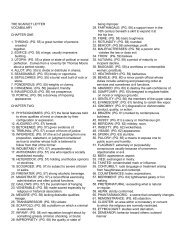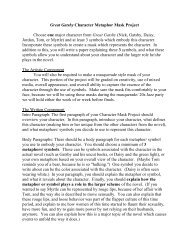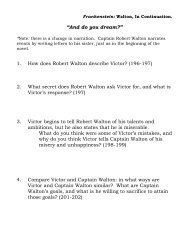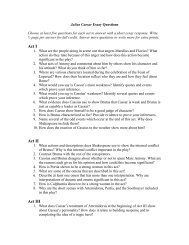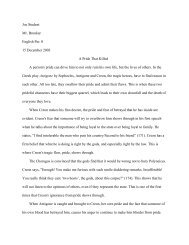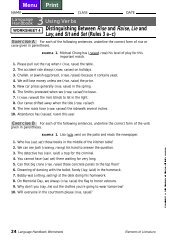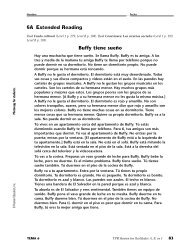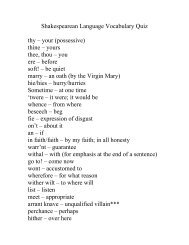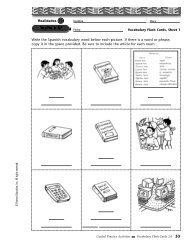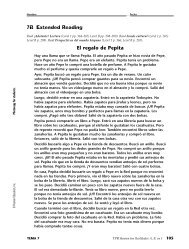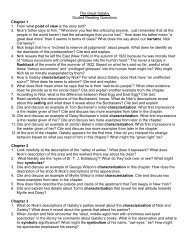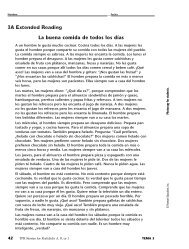Notes from Practical Short Story Writing Three Conflicts ... - CIBACS
Notes from Practical Short Story Writing Three Conflicts ... - CIBACS
Notes from Practical Short Story Writing Three Conflicts ... - CIBACS
You also want an ePaper? Increase the reach of your titles
YUMPU automatically turns print PDFs into web optimized ePapers that Google loves.
<strong>Three</strong> <strong>Conflicts</strong>, <strong>Three</strong> Laws<br />
<strong>Notes</strong> <strong>from</strong> <strong>Practical</strong> <strong>Short</strong> <strong>Story</strong> <strong>Writing</strong><br />
• All stories must tell of a struggle, or conflict.<br />
Man against man<br />
Man against circumstances, or nature<br />
Man against himself<br />
• Make your ideas hit somebody—hard<br />
• All conflicts must be of vital importance to the characters involved<br />
• The consequences of failure in their struggle must be disastrous<br />
• Everyday consequences are important to ordinary people<br />
Ways to get started<br />
Form a word to an idea (30-31)<br />
Word association (31-33)<br />
Expanding a theme (33-34)<br />
Inversion (35-36)<br />
Ideas <strong>from</strong> Pictures (36-38)<br />
All in the Day’s Work (38)<br />
Key is observation all the time = notebook<br />
Ch 3 – Plotting<br />
Basic Plotting (42-44)<br />
Situation<br />
Incident One<br />
Reaction<br />
Incident Two<br />
Reaction<br />
Frustration<br />
Reaction/Resolution<br />
Dramatic Scenes (48-50)<br />
Paint a vivid picture – show, don’t tell<br />
Create an air of anticipation<br />
Have Emotional Reversal<br />
Generate an urge to know what will happen next<br />
Technique – One<br />
Where to Begin and Why<br />
Usually begin at a dramatic high point, generally a character’s<br />
reaction stage
Within the first page or two of your story you should have:<br />
1. introduced the main character<br />
2. hinted at the problem<br />
3. set the scene<br />
4. established the mood<br />
5. cast your narrative hook<br />
The first four of these must blend in with narrative and dialogue.<br />
The last one must stand out to grab your reader’s attention and<br />
hold it.<br />
Viewpoint<br />
Single major character<br />
Single minor character<br />
Ranconteur – story teller<br />
Omniscient – should still identify with one character most of the time<br />
Reader must know who the main character is. Don’t hop around.<br />
To decide who the viewpoint character will be, ask, “Whose problem<br />
is it?”<br />
If the characters whose problem it is are not likable, you may choose<br />
another character as the observer to hold the point of view.<br />
Usually don’t use Omniscient for short stories<br />
Characterization – indirect vs. direct<br />
Know the main character intimately and sketch the minor ones<br />
Model characters on people you know or have met<br />
Methods of character presentation:<br />
Direct Description (blend and keep to a minimum)<br />
Dominant trait (slightly exaggerated)<br />
Appearance (don’t overdo weird things)<br />
Dialogue<br />
Actions – movements and gestures (creative verbs)<br />
Thoughts and emotions<br />
Surroundings and others’ reactions (stereotyping)<br />
Dialogue<br />
Be alert to nuances of speech<br />
Don’t use (out)dated dialogue<br />
Use the correct dialect for each character (but sparingly)<br />
Functions – advance the story, characterize, provide info.,<br />
convey emotions
Use a balanced mix of narrative and dialogue<br />
Be clear and not ambiguous<br />
Use different words for “said”<br />
(See examples on page 80-81 for creating dialogue)<br />
Compare voices with similes and physical reactions<br />
Use “with ____” instead of “said”<br />
Motivation – know your characters so you’ll know how they will<br />
and will not act in given situations<br />
Flashback – almost always necessary at some stage in a story because you<br />
usually begin with the character in a mess (dramatic high point); avoid<br />
confusing the reader; recall only the incidents that have a direct bearing on<br />
the story<br />
Handling Flashbacks<br />
The “tell me”<br />
Song to memory<br />
A forgotten name<br />
Tense – use past perfect until you can distinguish and then use past<br />
Transition – moving <strong>from</strong> place to place and scene to scene; don’t confuse<br />
the reader and try to offer hints about where the characters are headed; can<br />
use a gap in the page or standard words and phrases (later that evening);<br />
emotion; focus on objects; natural elements



